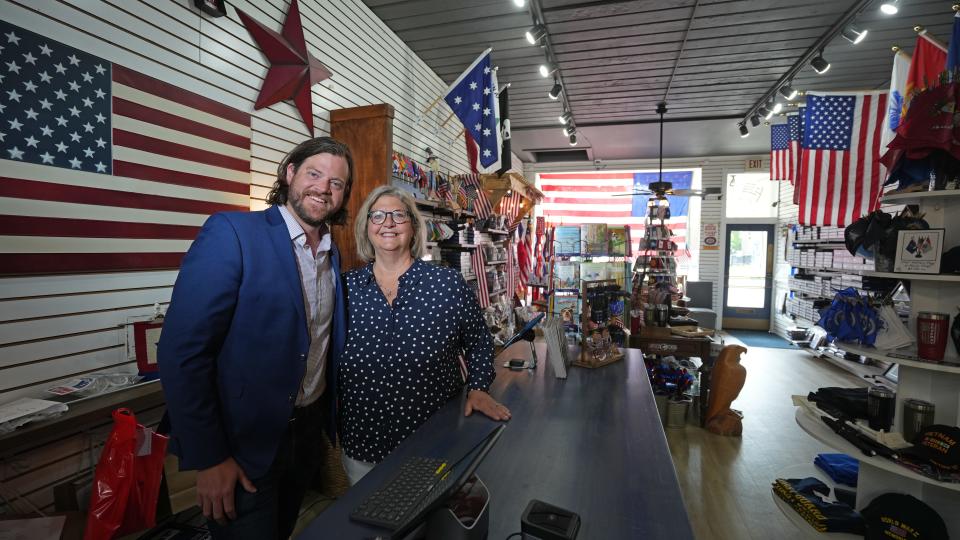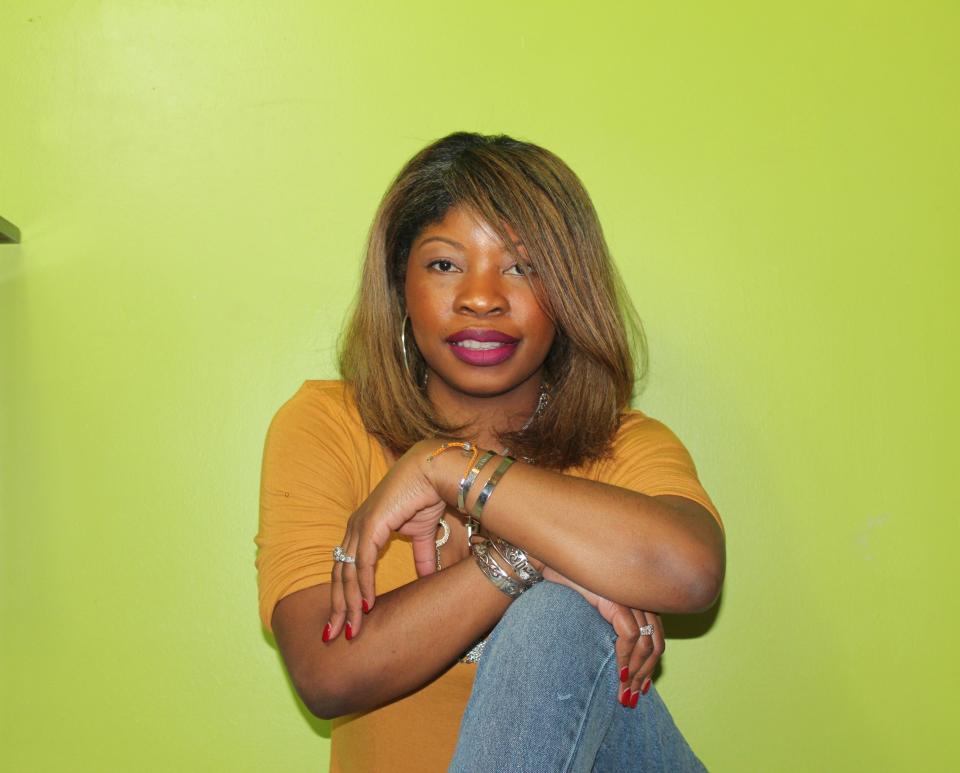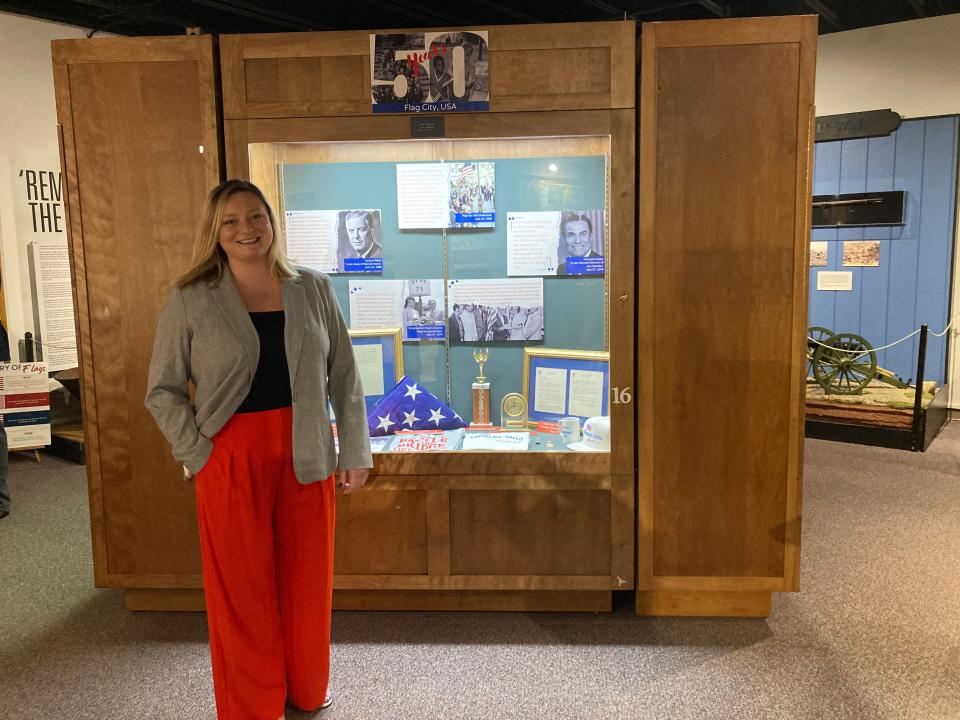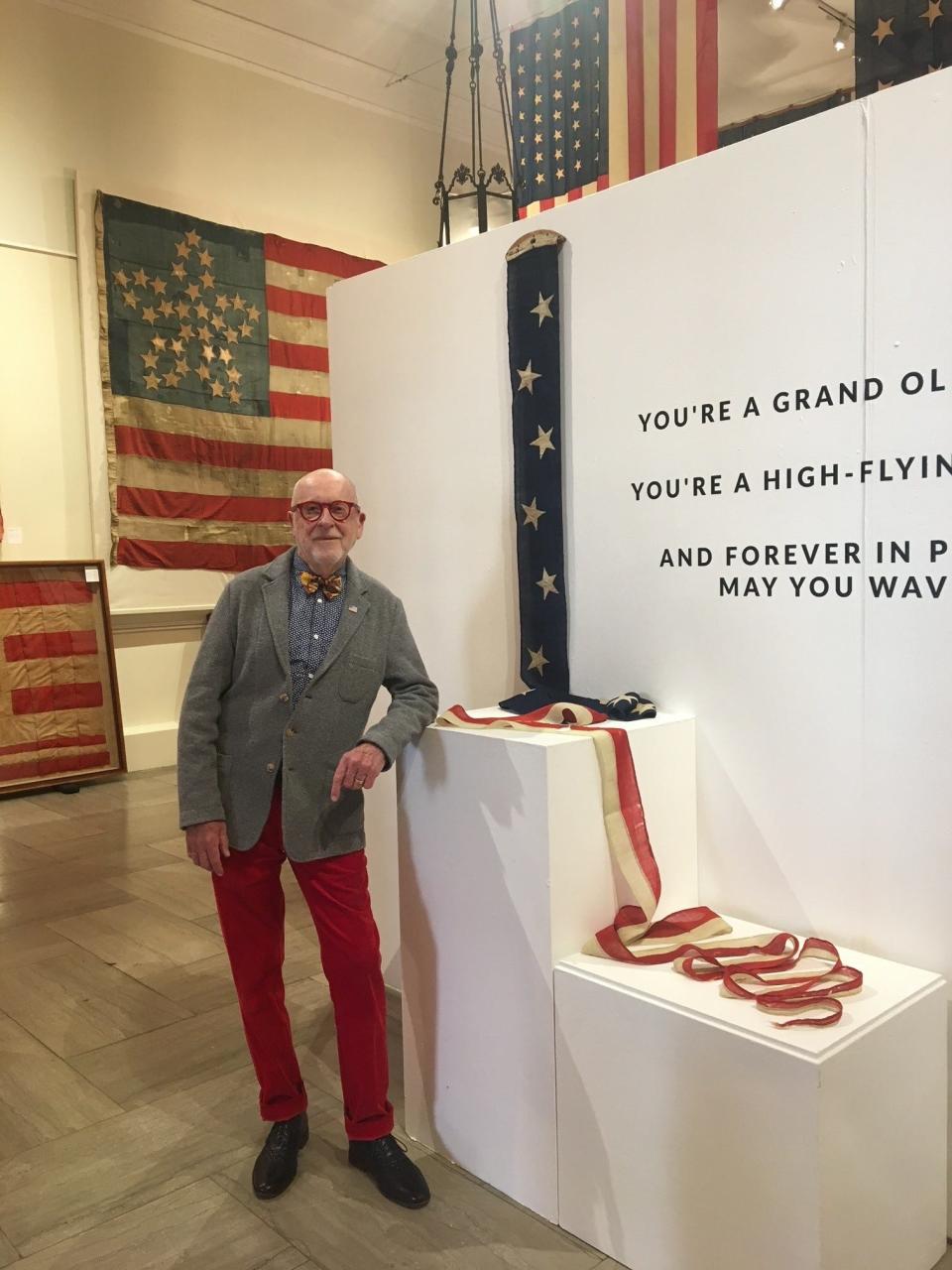What does the American flag mean to you? Sacrifice, skepticism, respect, pride, hope
America's founding fathers left their descendants with little guidance on what the nation's flag means.
Their resolution from June 14, 1777, was surprisingly sparse for what would become one of the country's most enduring symbols. At just 32 words, it did not explain why red, white and blue were chosen or what the stripes meant.
In the centuries since, the American flag has been draped across the casket of presidents and veterans, spread across the field of Super Bowls, waved by children in Fourth of July parades, burned in a protest outside a political convention and hung upside down at the home of a U.S. Supreme Court justice.
In the vacuum of prescribed meaning, Americans have imbued the flag with their own: sacrifice, freedom, patriotism, nationalism, pride, disappointment and hope. The flag reflects how Americans feel about their country, its past and its future.
Amid a polarizing election year and before the Fourth of July, several Americans shared what the American flag means to them.

A family tradition for The Flag Lady
Lori Watson's mother used to sell the American flag door-to-door during her lunch break as a legal secretary. Now, Lori and her son Harrison run The Flag Lady, one of the largest flag companies in the country selling more than 15,000 American flags each year.
"My great-grandmother carried a little four-by-six-inch flag on a stick in the hopes that she could wave it someday," said Lori Watson from her shop in Columbus, Ohio. "That pride and passion is unbelievable for such a simple, simple symbol."
With a vision of God and country, Watson's mother, Mary Haley Leavitt, started selling American flags when they were hard to purchase outside of hardware stores between Memorial Day and Labor Day. Leavitt passed the business down to her daughter and grandson, who recalls sweeping the back porch and climbing under the store's tables with his cousin.
"The American flag is a sideless symbol. In a world that seems dead-set on tearing itself apart, it is meant to be a symbol of unity," Harrison Watson said. "At times, we have stood up together to show the best version of those ideals. At times, we've fallen short. We're human. But at the end of the day, that symbol represents the highest of those ideals."
While every sale can be meaningful, Lori Watson recalls a World War II veteran visiting the store shortly after Sept. 11. The veteran hammered his walking stick on the floor to get customers' attention and said: "I could die today knowing my country is not complacent about what I gave up."
"The flag means hope, that as a people, we will ultimately come together and do the right thing," Lori Watson said. "It is a timeless symbol and that's why it has endured for all these years."
Feelings about the flag shift after Jan. 6 attack
Katrina Beals, a 30-year-old speech pathologist living in Grand Rapids, Mich., described herself as a staunch Democrat but wants to avoid polarization. Her goal is to “just become more open to conversations. Hearing other people's perspectives and seeing people as people first, and not their political affiliation."
A Mexican American, Beals said she long considered herself patriotic − but events like the Jan. 6, 2021, insurrection at the U.S. Capitol and the temperament of national politics since former President Donald Trump’s election have dampened her outlook.
At times, the American flag can evoke emotions of shame and embarrassment for Beals.
“It makes me a little bit sad. I love having pride for this country, but there's definitely that moment of hesitancy now when I see an American flag,” she said.
Still, Beals believes the flag can represent values it’s long been associated with − saying this year’s presidential election will be a "fight for the flag.”
“I think it’s really going to depend on what the outcome is, and seeing what Americans are feeling. Right now, it doesn’t really feel like the flag represents freedom.”
An image shows solidarity, strength after Sept. 11

At 5:01 p.m. on Sept. 11, 2001, photographer Thomas E. Franklin watched as three New York City firefighters removed an American flag from a yacht's mast near the World Financial Center. They carried the flag to what would later be known as Ground Zero and hoisted it onto a pole amidst the rubble of the fallen World Trade Center towers.
"It was not a performance," said Franklin, who worked for The Bergen Record at the time. "They didn't know they were being photographed. It was a very chaotic scene. They saw it was just an opportunity to do what they did."
Franklin's photograph of that moment quickly became an iconic image of American resilience during a horrific tragedy. The photograph, distributed by the Associated Press, was published in newspapers across the country. It was featured on a postage stamp that raised more than $10 million for victims of Sept. 11.
"It was one of the only photos of 9/11 that did not directly depict death and destruction. It was a picture of three firemen who were essentially the soldiers in this war that we found ourselves in," said Franklin, now an associate professor of multimedia journalism at Montclair State University in New Jersey.
"The fact that these three firemen hoisted this flag, I think was viewed as a very strong act of patriotism and solidarity and strength that the country desperately needed in the hours after 9/11."
'Deeper historical, cultural, and political messages' behind the flag

Growing up in Georgia, the American flag reminded Kia Smith of the Fourth of July, family, and cookouts. Now 42, her experiences abroad and observing political movements have made her skeptical of wearing or displaying the flag.
Smith said she first questioned the flag when studying abroad in Tunisia in 2006. Following the United States’ declaration of its war on terror, she said people there felt the flag represented anti-Muslim sentiment – something she had to explain she did not hold just because of her nationality.
"As a Black woman in America, it was really interesting to be placed in a situation where I was seen as an American and confronted with a lot of the imperialism and colonialism that comes with being American,” Smith said. “Seeing what people outside of the United States, how they view the flag and American policy and values, was the first time when I had a moment of like, ‘what is this really?'”
Smith said she again felt like the flag did not represent her when it was flown by groups like the Tea Party, Make America Great Again Republicans, and Black Lives Matter counter-protesters.
“The only time I honestly feel tension is around the Olympics because there are so many incredible athletes and I want to have pride,” Smith said. “If I put on the U.S. flag, it’s not just about the games. There are deeper historical, cultural, and political messages behind that flag that don’t align with my lived values.”
A symbol of respect

Scott Miller, of Washington, remembers pledging his allegiance to the American flag in school. When he grew up, he became a minister and made friends in law enforcement.
After serving as a volunteer police chaplain, he was inspired to form the Thin Blue Line Foundation which offers resources for police officers and their families, including counseling and spiritual support. The nonprofit distributes a version of the thin blue line flag Miller created with a graphic designer.
“The main thing we wanted to have there was the blue line representing what separates good and evil, chaos and order,” Miller said. “And then anybody that was law enforcement would recognize what it stood for.”
Miller said the American flag reminds him of freedom and the military lives lost fighting for it. He added that it is a symbol of respect at a time when he senses a growing disrespect for authority, including police officers and politicians.
“It's really hard for me when people burn the flag or call the flag racist,” Miller said. “We’re living in a time where people are trying to tear down everything that our country was founded on, and I think the flag is just one additional thing that they’re trying to do that with.”
'You can be patriotic and liberal'
The evolution of Jessica DeWolfe’s relationship with the American flag is one of acceptance and realistic optimism.
The 37-year-old’s earliest memories of the emblem bring her back to elementary school, singing patriotic hymns and standing for the pledge of allegiance.
Those positive emotions of unity evolved as she reached adulthood during the rise of the conservative Tea Party movement.
“There’s a growing period when you realize the U.S. history that you were taught is not the truth or the whole story,” DeWolfe told USA TODAY in an interview. “That brings up a lot of complicated feelings because that flag did not represent everyone, and it could be argued that it still doesn’t represent everyone so far.”
The Minneapolis resident and public health worker has reflected on how far-right groups have used the national emblem to exclude marginalized communities.
Now, DeWolfe isn’t convinced that either side of the aisle owns the flag.
“You can be patriotic and liberal,” she said. “Those aren’t mutually exclusive.”
Community and reflection in Flag City, USA

When John B. Cooke moved to Findlay, Ohio in 1968, he had a vision of a city bedecked in American flags for Flag Day. A member of the Sons of the American Revolution, Cooke purchased 14,000 small flags with donations from local organizations and residents. Local scouts passed them out to neighbors and friends to display on June 14.
"One person had a vision and an idea and everybody rallied around it," said Findlay Mayor Christina Muryn, who coincidentally got married on Flag Day 10 years ago. "That really is the essence of our community. When somebody has a good idea, we're doers."
Six years after Cooke's grand idea, a resolution from the U.S. House of Representatives officially designated the city in Northwest Ohio as Flag City, USA. Findlay held that title exclusively until 1999 when Redmond, Oregon claimed the name, too.
Sarah Foltz's first memories of the American flag were of the small ones she'd wave at Findlay's many parades. She now serves as executive director of the Hancock Historical Museum, which recently celebrated the city's 50th anniversary as Flag City with children painting flags, playing ring toss and eating snow cones.
"You don't really question why you're flying flags as a child," Foltz said. But now, she said the flag signifies reflection. "It means that our country has come so far − and not without struggle and not without challenges to this day."
When the museum's education coordinator Deb Wickerham thinks about the American flag, she remembers the sacrifice her 19-year-old cousin made in the Vietnam War. She thinks of the veterans she helped visit the Washington D.C. memorials as co-founder of Flag City Honor Fight. "We are allowed to wave that flag because of what those men and women did."
'Totally out of control' flag collection

Peter Keim's affection for the American flag began as a young boy in Erie, Pennsylvania watching his grandfather raise the stars and stripes during World War II.
"He taught me how to raise the flag, how to retire the flag, how to bring it in at sunset, make sure it didn't touch the ground at all, make sure if the weather didn't look too good to bring the flag in," Keim said. "That was sort of the beginning."
Years later, Keim bought an old flag stashed in a paper bag at an antique sale for $40. To Keim's surprise, his purchase was a hand-sewn 13-star flag. About a year later, he bought a second old flag.
"Then, it just got totally out of control," he said. "I collected well over 700 historic flags and was recognized as probably the most complete collection in the United States."
Keim's collection has been featured in museums and in Bergdorf Goodman's windows on the first anniversary of Sept. 11. He wrote a book titled "A Grand Old Flag" and often asks people to describe the American flag in one word.
"America," Keim said when asked to answer his own prompt. "It's America and all that America stands for. Strength, freedom, liberty, perseverance, equality, all of these things have been within our flag over time."
Jessie Balmert is a political reporter for the USA TODAY Network Ohio Bureau, which serves the Columbus Dispatch, Cincinnati Enquirer, Akron Beacon Journal and 18 other affiliated news organizations across Ohio. She can be reached at jbalmert@gannett.com.
This article originally appeared on Cincinnati Enquirer: Sacrifice and skepticism: How Americans view the US flag

